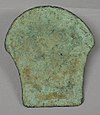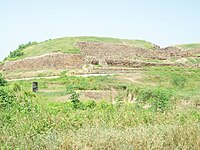A | B | C | D | E | F | G | H | CH | I | J | K | L | M | N | O | P | Q | R | S | T | U | V | W | X | Y | Z | 0 | 1 | 2 | 3 | 4 | 5 | 6 | 7 | 8 | 9
The predecessors to the contemporary Army of India were many: the sepoy regiments, native cavalry, irregular horse and Indian sapper and miner companies raised by the three British presidencies. The Army of India was raised under the British Raj in the 19th century by taking the erstwhile presidency armies, merging them, and bringing them under the Crown. The British Indian Army fought in both World Wars.
 |
| History of science and technology in the Indian subcontinent |
|---|
| By subject |
The armed forces succeeded the military of British India following India's independence in 1947. After World War II, many of the wartime troops were discharged and units disbanded. The reduced armed forces were partitioned between India and Pakistan. The Indian Armed Forces fought in all fours wars against Pakistan and two wars against People's Republic of China in 1962 and 1967. India also fought in the Kargil War with Pakistan in 1999, the highest altitude mountain warfare in history.[citation needed] The Indian Armed Forces have participated in several United Nations peacekeeping operations and are presently the second largest contributor of troops to the peacekeeping force.
-
Indian warrior in Armor by Edwin Lord Weeks.
-
Ancient Indian Antennae sword; Metalwork, 1500–500 BCE.
-
Ancient Indian Ax Blade, 1500–1000 BCE.
Indus Valley Civilisation
Fortified towns have been excavated from Indus Valley civilisation with thick and tall walls. Banawali is among the earliest sites in the world where moats have been discovered. These forts also feature square and round bastion and contain a citadel constructed at an elevated height.[1] Sites such as Mohenjo Daro and Dholavira exhibit some outstanding examples of Bronze Age Indian fortifications with their thick tall walls, with the walls made of burned bricks at some places solid mud-brick embankment have been discovered which run for twenty five feet (7.5 meters) without reaching the bottom.[2] Sites such as Desalpar, Dholavira's have yielded massive stone fortifications and the acropolis is extensively fortified with tall standing walls and furnished with ramparts and gateways.[3][4]
An Indus seal depicting a soldier firing a composite bow was unearthed in Shortugai, Afghanistan, which indicates that Indus people were already familiar with it long before they were depicted in ancient Indian reliefs. Another copper seal from Mohenjo Daro shows a horned hunter holding a composite bow.[5]
-
Defensive wall of Dholavira, Gujarat, India, 2650 BCE.
-
Kalibangan Fortification wall and square bastions, Rajasthan, India, 2500 BCE.
The Vedic and Mahajanapada period
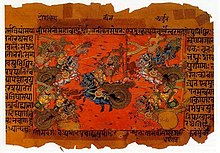
An excavation at Sinauli's necropolis has yielded copper swords, helmets and chariots, dating from 2000 to 1800 BC, which suggests the presence of a warrior Indo-Aryan people who followed Vedic religion in the region during the Copper-Bronze Age (2000 BC–1200 BC).[6]
The Rigvedic tribes of Indo-Aryans were led by their kings (raja) and engaged in wars with each other and other tribes. They used bronze weapons and horse-drawn spoke-wheeled chariots described prominently in the Rigveda. The main share from the booty obtained during cattle raids and battles went to the chief of the tribe. The warriors belonged to the Kshatriya varna. The earliest of such battles is noted in Rigveda as the Battle of the Ten Kings.
The Vedas and other associated texts dating to the post-Rigvedic (Iron Age) Vedic period (ca. 1100–500 BC) contain the earliest written references to armies in India. The earliest known application of war elephants dates to this period; the animals are mentioned in several Vedic Sanskrit hymns.[7]


The two great epics of Hinduism, the Ramayana and the Mahabharata, center on conflicts between the emerging Mahajanapadas and refer to military formations, theories of warfare and esoteric weaponry. They discuss standing armies that used in war chariots, war elephants and even mythical flying machines. The Ramayana describes in great detail the fortifications of Ayodhya. The Mahabharata describes various military techniques such as Chakravyuha used in the Kurukshetra War.
The Indian dynasties
Shaishunaga dynasty
The expansionist King Bimbisara conquered Anga in what is now West Bengal and strengthened the military of Magadh's capital, Rajagriha. Ajatashatru built a new fort at Pataliputra, Magadh's new capital, to launch an attack on Licchavis across the Ganges River. Jain texts tell that he used two new weapons; catapults and a covered chariot with swinging mace that has been compared[by whom?] to modern tanks.
Nanda dynasty
The Nanda dynasty originated from the region of Magadha in ancient India during the 4th century BC. At its greatest extent, the empire ruled by the Nanda dynasty extended from Bengal in the east, to Punjab in the west and as far south as the Vindhya Range.
In 327 BC Alexander the Great began his foray into Punjab. King Ambhi, ruler of Taxila, surrendered the city to Alexander. Alexander fought an epic battle against the Indian king Porus in the Battle of Hydaspes (326). Despite winning, Alexander decided to turn back and end his campaign due to pressure from his generals and troops who were tired and fatigued because of constant battle.
Maurya Empire
According to Megasthenes, who served as an ambassador from the Seleucid Empire, Chandragupta Maurya built an army consisting of 30,000 cavalry, 9,000 war elephants, and 600,000 infantry. Chandragupta conquered much of Indian subcontinent, establishing an empire from the Arabian Sea to the Bay of Bengal. He then defeated the Hellenistic Seleucid Empire under Seleucus I Nicator to conquer the regions to the west of the Indus River. He then turned south, taking over much of what is now Central India. His military was administered by six chairs, one for each of the four arms of the army (infantry, cavalry, elephants, and chariots), one chair for the navy, and one for logistics and supply.
Infantry at this time was most commonly armed with a longbow made of bamboo and a single- or double-handed broadsword probably similar to the khanda. Other foot soldiers could be armed with a large animal hide tower shield and a spear or javelins. Cavalry carried spears. Elephants were mounted, sometimes allegedly with howdahs, which may be an Indian invention[9] by archers or javelin throwers, with a mahout around the animal's neck. Chariots by this time were in definite decline, but remained in the army due to their prestige.
In 185 BCE, the last Mauryan ruler was assassinated by Pushyamitra Shunga, the Commander-in-Chief of the Mauryan armed forces.
Shunga Empire

War and conflict characterized the Shunga period. They are known to have warred with the Kalingas, Satavahanas, the Indo-Greeks, and possibly the Panchalas and Mathuras.
Extent of the Shunga Empire's wars with the Indo-Greek Kingdom figure greatly in the history of this period. From around 180 BCE the Indo-Greek ruler Demetrius I of Bactria conquered the Kabul Valley and is theorized to have advanced into the trans-Indus. The Indo-Greek Menander I is credited with either joining or leading a campaign to Pataliputra with other Indian rulers; however, very little is known about the exact nature and success of the campaign. The net result of these wars remains uncertain.
Pushyamitra is recorded to have performed two Ashvamedha Yagnas and Shunga imperial inscriptions have extended as far as Jalandhar. Scriptures such as the Divyavadhana note that his rule extended even farther to Sialkot, in the Punjab. Moreover, if it was lost, Mathura was regained by the Shungas around 100 BCE (or by other indigenous rulers: the Arjunayanas (area of Mathura) and Yaudheyas mention military victories on their coins ("Victory of the Arjunayanas", "Victory of the Yaudheyas"), and during the 1st century BCE, the Trigartas, Audumbaras and finally the Kunindas also started to mint their own coins). Accounts of battles between the Greeks and the Shunga in Northwestern India are also found in the Mālavikāgnimitram, a play by Kālidāsa which describes a battle between Greek cavalrymen and Vasumitra, the grandson of Pushyamitra, on the Indus river, in which the Indians defeated the Greeks and Pushyamitra successfully completed the Ashvamedha Yagna.
The Indo-Greeks and the Shungas seem to have reconciled and exchanged diplomatic missions around 110 BCE, as indicated by the Heliodorus pillar, which records the dispatch of a Greek ambassador named Heliodorus, from the court of the Indo-Greek king Antialcidas, to the court of the Shunga emperor Bhagabhadra at the site of Vidisha in central India.
The Golden age
Classical Indian texts on archery in particular and martial arts in general are known as Dhanurveda. Several classics of the genre date from this period.
Satavahana dynasty

According to some interpretations of the Puranas, the Satavahana family belonged to the Andhra-jati ("tribe") and was the first Deccanese dynasty to build an empire in daksinapatha (southern region). The Satavahanas (also called Andhra and Shalivahan) rose to power in modern Telangana, Andhra Pradesh and Maharashtra around 200 BCE and remained in power for about 400 years. Almost the whole of present-day Telangana, Maharashtra, Madhya Pradesh, Chhattisgarh, Odisha, Goa, Karnataka, and Andhra Pradesh came under Satavahana rule. Their first capital was Koti Lingala, as well as Paithan, then called Pratishthan.
Simuka, the dynasty's founder, conquered Maharashtra, Malwa and part of Madhya Pradesh. His successor and brother Kanha (or Krishna) further extended his kingdom to the west and the south. He was succeeded by Satakarni I, who defeated the Shunga dynasty of North India. His successor, Gautamiputra Satakarni, defeated the invading Indo-Scythians, Indo-Parthians and Indo-Greeks. His empire extended up to Banavasi in the south, and included Maharashtra, Konkan, Saurashtra, Malwa, west Rajasthan and Vidharbha. Later, Satavahana rulers lost some of these territories. Satavahana power revived briefly under Yajna Sri Satakarni but declined after his death.
Mahameghavahana dynasty
The Mahameghavahana dynasty was an ancient ruling dynasty of Kalinga after the decline of the Mauryan Empire. The third ruler of the dynasty, Khārabēḷa, conquered much of India in a series of campaigns at the beginning of the common era. Kaḷingan military might was reinstated by Khārabēḷa. Under Khārabēḷa's generalship, the Kaḷinga state had a formidable maritime reach with trade routes linking it to the then-Simhala (Sri Lanka), Burma (Myanmar), Siam (Thailand), Vietnam, Kamboja (Cambodia), Borneo, Bali, Samudra (Sumatra) and Yawadvipa (Java). Khārabēḷa led many successful campaigns against states of Magadha, Anga, Satavahanas and the South Indian regions of Pandyan Empire and expanded Kaḷinga as far as the Ganges and the Kaveri.
The Kharavelan state had a formidable maritime empire with trading routes linking it to Sri Lanka, Burma, Thailand, Vietnam, Cambodia, Borneo, Bali, Sumatra and Java. Colonists from Kalinga settled in Sri Lanka, Burma, as well as the Maldives and Maritime Southeast Asia. Even today Indians are referred to as Keling in Malaysia because of this.
The main source of information about Khārabeḷa is his famous seventeen line rock-cut Hātigumphā inscription in a cave in the Udayagiri hills near Bhubaneswar, Odisha. According to the inscription, he attacked Rajagriha in Magadha, thus defeating the Indo-Greek king Demetrius III Eucaerus retreat to Mathura.
Gupta dynasty
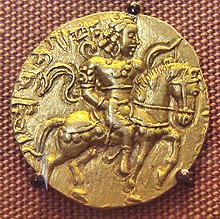

Siva-Dhanur-veda discusses the military of the Gupta Empire. The Guptas relied less on armoured war elephants compared to previous south Asian empires. The use of chariots had declined heavily by the time of the Guptas, as they had not proved very useful against the Greeks, Scythians, and other invaders. Guptas utilised famously used cavalry archers, and it became the prestige arm of the military as evidenced by coinage. Heavy cavalry clad in mail armour and equipped with maces and lances would have used shock action to break the enemy line.
They also employed infantry similar to previous periods: Archers with a longbow composed of bamboo or metal and fired a long bamboo cane arrow with a metal head; iron shafts were used against armoured elephants. They also sometimes used fire arrows. Archers were frequently protected by infantry equipped with shields, javelins, and longswords. The Guptas also maintained a navy, allowing them to control regional waters.
Samudragupta seized the kingdoms of Ahichchhatra and Padmavati early in his reign. Later, he took the Kota kingdom and attacked the tribes in Malvas, the Yaudheyas, the Arjunayanas, the Maduras and the Abhiras. He also subjugated the remnants of the Kushan Empire. By his death in 380, he had conquered over twenty kingdoms.
4th century CE Sanskrit poet Kalidasa, credits Chandragupta II with having conquered about twenty one kingdoms, both in and outside India. After finishing his campaign in the East and West India, he proceeded northwards, subjugated the Parasikas,[11] then the Hunas and the Kambojas tribes located in the west and east Oxus valleys respectively.[12] of the Indian subcontinent; the Gupta empire was the most powerful empire in the world during his reign, at a time when the Roman Empire in the west was in decline.
Skandagupta faced with invading Indo-Hephthalites or White Huns, from the northwest. Skandagupta had warred against the Huns during the reign of his father, and was celebrated throughout the empire as a great warrior. He crushed the Huns invasion in 455, and managed to keep them at bay; however, the expense of the wars drained the empire's resources and contributed to its decline
The Classical age
Empire of Harsha
Emperor Harsha (606–647) ruled the Empire of Harsha covering northern India for over forty years. His father, a king of Thaneswar, had gained prominence by successful wars against the Huns. Harsha had plans to conquer the whole of India, and carried on wars for thirty years with considerable success. By 612 he had built up a vast army with which he conquered nearly all North India up to the Narmada river. In 620 he invaded the Deccan Plateau but was repelled by Pulakeshin II.
The Chalukyas and Pallavas
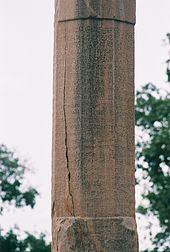
In South India, the Chalukyas and the Pallavas gained prominence. The Chalukya ruler Pulakeshin II's expansionism started with minor campaigns against the Alupas, Gangas and others. He defeated the Pallava king Mahendravarman and conquered the Cheras and the Pandyas. His greatest military success, the defeat of Harshavardhana (also known as Harsha), depleted his treasury, forcing him to end his expansionist campaigns.
The Pallava king Narasimhavarman vowed to avenge Mahendravarman's defeat by Pulakeshin II. He invaded Vatapi with an army headed by his general Paranjothi. He defeated the Chalukyas, killing Pulakeshin II in 642. Clashes between the Chalukyas and the Pallavas continued for a century, until the Chalukya king Vikramaditya II won a decisive victory against the Pallavas in 740. The Rashtrakutas overthrew the Chalukya empire in 750. During the 970s, Tailapa II overthrew the Rashtrakutas and recovered most of the Chalukya Empire, except for Gujarat. The Chalukyas of this period are known as the Kalyani Chalukyas, as Kalyani was their capital. They clashed intermittently with the Cholas.
The Chola Empire
The Cholas were the first rulers of the Indian subcontinent to maintain a navy and use it to expand their dominion overseas. Vijayalaya Chola defeated the Pallavas and captured Thanjavur. In the early 10th century the Chola king Parantaka I defeated the Pandyan king Maravarman Rajasimha II and invaded Sri Lanka. The Rashtrakuta ruler Krishna III defeated and killed Parantaka I's son Rajaditya in about 949.
Uttama Chola reigned 970–85. Inscriptions tell that at least from his time, Chola warriors wore waist coats of armour. Hence, one regiment was called Niyayam-Uttama-Chola-tterinda-andalakattalar.[what language is this?] Paluvettaraiyar Maravan Kandanar served as a general under Uttama and his predecessor, Sundara.
Rajaraja Chola began his military career with the conquest of the Cheras in the Kandalur War. He captured the Pandya ruler Amara Bhujanga, the town of Vizhinjam, and a part of Sri Lanka. In the 14th year of his reign (998–999) he conquered the Gangas of Mysore, the Nolambas of Bellary and Eastern Mysore, Tadigaipadi, Vengi, Coorg, the Pandyas and the Chalukyas of the Deccan. During the next three years, he subdued Quilon and the northern kingdom of Kalinga with the help of his son Rajendra Chola I. Rajendra later completed the conquest of Sri Lanka, crossed the Ganges, and marched across Kalinga to Bengal. He sent out a great naval expedition that occupied parts of Java, Malaya, and Sumatra. The Cholas were brought down by the Hoysalas from the west and Pandyas from the south.
The Gurjar-Pratiharas, Palas and Rashtrakutas
The Arab scholar Sulaiman described the emperor of the Rashtrakuta dynasty as one of the four great kings of the world in the 9th century.[13] In middle of 9th century, the Palas under Devapala attacked and subjugated the Gurjara-Pratiharas. Led by Mihir Bhoja, the Pratiharas and their allies defeated Narayan Pala after the death of Devapala.
There were many battles between the Gurjar Pratiharas under Bhoj and the Rashtrakutas under Krishna II with mixed results. When the Rashtrakuta king Indra III attacked Kanauj, Mahipala I, Mihir Bhoj's successor, fled; he later returned.
Al-Masudi wrote that in 915, during Mahipala's rule, the Pratiharas were at war with the Muslims in the west and the Rashtrakutas in the south, and that the Gurjar Pratiharas had four armies of about 80,000 men each.
Arab conquest of Sindh
In 712, an Arab general, named Muhammad bin Qasim Al-Thaqafi (Arabic: محمد بن قاسم) (c. 31 December 695 – 18 July 715), attacked and conquered Sindh kingdom which is mainly situated in Indus valley area (after partition, now in modern-day Pakistan); by the time Sindh was ruled by Raja Dahir of the Rai dynasty, and this dynasty was at war with Arabs. Though they defeated several Arab invasions before 712 CE, this time being deprived of local Buddhist people's support, Sindh was captured and the first step of Islamic foundation in India was created. Chach Nama (Sindhi: چچ نامو), written by Kàzí Ismáíl briefly discusses the events. However, the South Indian emperor Vikramaditya II of the Chalukya dynasty and the Pratiharas defeated the Arabs during the Caliphate campaigns in India (738 CE) when they tried to move eastward.
Zdroj:https://en.wikipedia.org?pojem=Military_history_of_India
>Text je dostupný pod licencí Creative Commons Uveďte autora – Zachovejte licenci, případně za dalších podmínek. Podrobnosti naleznete na stránce Podmínky užití.
Text je dostupný za podmienok Creative
Commons Attribution/Share-Alike License 3.0 Unported; prípadne za ďalších
podmienok.
Podrobnejšie informácie nájdete na stránke Podmienky
použitia.


